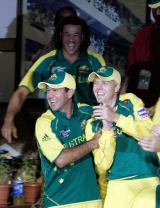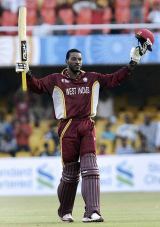
|

The Australians finally emerged victorious in a tournament that has eluded them
© Getty Images
|
|
The Champions Trophy is a much maligned tournament. The fact that it was
created with the sole purpose of making money to plough back into the
system irks some. Others suggest that it takes the shine off the World
Cup. For certain people just the fact that it is a one-day tournament
makes it a waste of time. The 2006 edition provided enough good games,
clear trends on which teams and players are on the rise and which are on
the wane, and plenty to talk about. To me, it was West Indies' tournament,
which Australia won.
The noise and the chatter
When the tournament began there was a very real danger that the rumbling
spat between the ICC and the Board of Control
for Cricket in India (BCCI) would blow-up into a full fledged crisis. With the
Indian board either taking shots at the ICC, or replying to remarks made
by the ICC, in the media, there was the chance that sports pages would
have been filled with Malcolm Speed and Lalit Modi, rather than hard
cricket. That this tournament began with a qualifying round - and this
inevitably yields one-sided matches, meant that it took some time before
the cricket was hot enough to push out the officials from the sports
pages. Once things began to fall into place, though, it all changed.
The champions
Chris Gayle made this tournament his own. There are plenty of batsmen in
the world capable of scoring 474 runs in a tournament, but few who can do
in the crowd-pulling manner that Gayle did. His hitting - against any sort
of bowler, on any kind of pitch - was reminiscent somehow of an era when
West Indies dominated cricket. It's easy to romanticise these things, but
Gayle is just such a throwback to a time when a batsman had to worry more
about his off stump than anti-ambush marketing clauses that you make the
exception in his case. He clowns around at press conferences, celebrates
taking catches of wickets, or scoring hundreds, with anything from the
sublime to the ridiculous, and just bats on regardless.
Another star was Jerome Taylor, the leading wicket-taker. Loose limbed and
athletic, he ran in with pace and purpose, and really it should have
surprised no-one that he did as well as he did, including becoming the
first West Indian to pick up a hat-trick. Then there was Damien Martyn,
repeatedly coming in to bat after a wobble, steadying the ship with serene
batting. There was Stephen Fleming, handing out lessons on how to adjust
to different conditions and bat on tricky pitches.
The form book
The early phase of this tournament made it impossible to predict any
result with a degree of certainty. Pakistan beat Sri Lanka, West Indies
beat Australia, West Indies beat India, New Zealand beat South Africa,
South Africa beat Pakistan . The fact that the tournament was played in
three different venues, each providing differing pitches, meant that teams
had to adapt quickly, and often it was the team that displayed the most
tactical nous, and cricketing intelligence, on the day, that won, rather
than the better team. This meant that the tournament was wide open for a
lot longer than pundits initially expected.

|

Chris Gayle exhilarating batting was a throwback to an earlier era
© AFP
|
|
India, the hosts, being knocked out before the semi-final stage, along with
Sri Lanka, who appeared to have the early momentum, and Pakistan, left the
tournament with no Asian teams going into the last four, and this was a
disappointment. But the teams that did make it, South Africa, New Zealand,
West Indies, and of course, Australia, were the ones that had played the
best cricket at key moments in the tournament.
The pitches
There was only one really bad pitch all tournament, the one at the
Brabourne Stadium for the South Africa-New Zealand match. It deteriorated
too rapidly, crumbling in the second half, making it next to impossible
for South Africa to chase a target. Another one that came close to being
unacceptable was the green seamer at Mohali where South Africa rolled
Pakistan over, and here too the batsmen had little chance of mastering the
bowlers.
Barring those two matches, the pitches for the tournament were fine, with
the only odd losing captain whinging from time to time. The pitches
certainly weren't of the kind people take for granted in India - flat
batting strips where even 300 is not safe, and they certainly made for
better cricket in many ways. Captaincy became a crucial element as
strategy played a huge part in each match, and high quality batsmen
willing to apply themselves were in demand.
The bits and bobs
Although the crowds largely stayed away from the games through a
combination of India's poor performance and the high prices of tickets,
when they did make it to the grounds they were treated better than is
normally the case. The stadia in question, at Ahmedabad, Mumbai and
Mohali, have improved out of sight, and it's now realistically possible to
get a seat, something to eat, and reasonable amenities at the ground. The
organisation - and though there's always plenty of room for improvement -
was a cut above the ordinary for India. Credit must go to all parties
involved - the ICC, the BCCI and the local associations, but mostly to the
men who ensured that through all the bickering, the work got done. They're
the officials whose names you don't see in the papers, and the ones that
play the most vital roles.
The result
The best team in the world qualified to play the final against the team
playing the best cricket in the world at the time. You couldn't ask for
more, if you were fair. And in the end, as has been the case in many grand
finals now - the 1999 World Cup final in England, the 2003 World Cup final
in South Africa, and now this - the Australians just blew away the
opposition. West Indies had one of their off days, Australia were too
strong overall, and go into the Ashes having won the one tournament that
eluded them. West Indies had mounted a creditable defence of their title,
and played with pride, something that gives you the hope that they can
give a good account of themselves when the carnival travels to their part of
the world, for the biggest tournament around, not far from now.
Anand Vasu is assistant editor of Cricinfo

